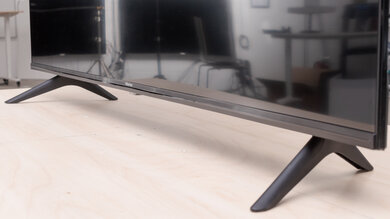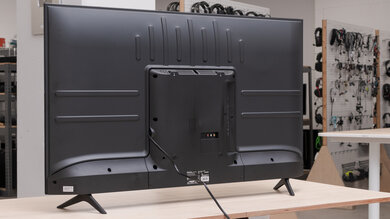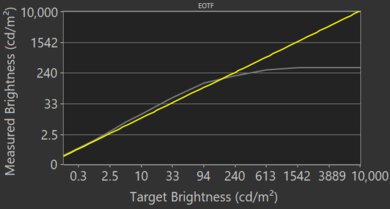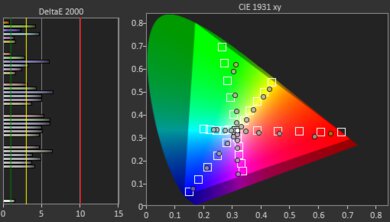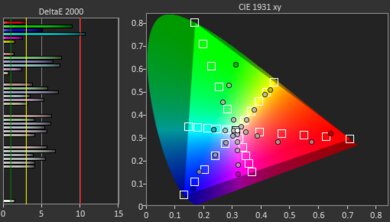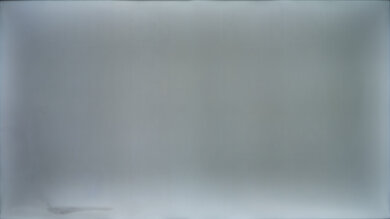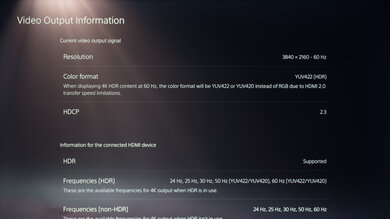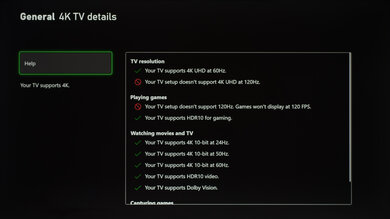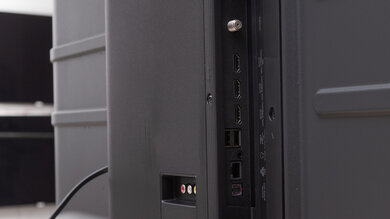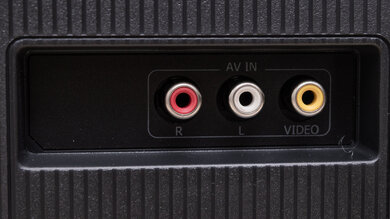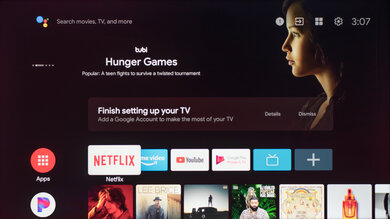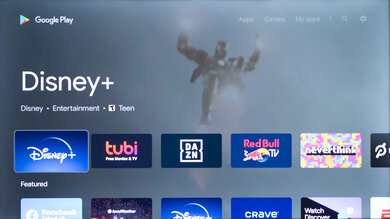The Hisense H6570G is an okay entry-level 4k TV. It lacks many features found on higher-end Hisense TVs, such as local dimming, a Black Frame Insertion feature, and a wide color gamut for HDR content. It has a VA panel that displays deep blacks, great for watching movies in the dark. It has decent reflection handling, but it doesn't get bright enough to combat glare in well-lit rooms. There aren't many extra gaming perks, and its input lag is higher than most TVs, but it should be fine for most casual gamers. Even though it's a 4k TV, it has some issues displaying native 4k content.
Our unit has a group of stuck pixels near the bottom left corner, and there's visible backlight bleed along the edges during near-dark scenes. We don't know how common that issue is for this model. We decided to still publish the results since our unit is functional and it doesn't significantly affect the test results (see our policy here). If you have this TV and experienced these same issues, let us know in the discussions.
Our Verdict
The Hisense H6570G is an okay overall TV. It's an okay choice for watching movies in a dark room because it displays deep blacks, but it lacks a local dimming feature. It's not ideal for wide seating arrangements, like watching sports with friends, because it has narrow viewing angles. It's alright for gaming with its decent response time and fairly low input lag. Unfortunately, HDR content doesn't pop the way it should because it doesn't display a wide color gamut and doesn't get very bright.
- Excellent contrast ratio.
- Upscales 720p and 1080p content well.
- Decent reflection handling.
- Narrow viewing angles.
- Doesn't display wide color gamut for HDR content.
- Uniformity issues.
The Hisense H6570G is okay for watching movies. It has an excellent contrast ratio, displaying deep blacks. However, our unit has uniformity issues, resulting in backlight bleed along the four edges. Sadly, it doesn't have a local dimming feature. It upscales 1080p content well, but there are some issues displaying native 4k content.
- Excellent contrast ratio.
- Upscales 720p and 1080p content well.
- Mediocre black uniformity.
- No local dimming feature.
The Hisense H6570G is alright for watching TV shows. It performs fairly well in moderately-lit rooms because it has decent reflection handling, but it doesn't get bright enough to combat glare. It also has narrow viewing angles, so it's not ideal if you want to watch shows with the entire family. Luckily, it upscales 720p content, like from cable boxes, without any issues.
- Upscales 720p and 1080p content well.
- Decent reflection handling.
- Doesn't get bright.
- Narrow viewing angles.
The Hisense H6570G is okay for watching sports. It has decent reflection handling if you watch in a well-lit room, but it doesn't get very bright. It has a decent response time, but you may notice image duplication with fast-moving content due to the TV's flicker. It has narrow viewing angles, and our unit has some dirty screen effect in the center, which may be distracting during sports.
- Upscales 720p and 1080p content well.
- Decent reflection handling.
- Decent response time.
- Doesn't get bright.
- Narrow viewing angles.
- Backlight flicker causes image duplication.
Alright for gaming. The Hisense H6570G has a decent response time, but you may notice image duplication due to the backlight's flicker. Its input lag is higher than most TVs; however, this only makes a difference with video games that require precise timing. It's good for dark-room gaming because it has excellent contrast, but our unit has uniformity issues.
- Excellent contrast ratio.
- Decent response time.
- Fairly low input lag.
- Mediocre black uniformity.
- Backlight flicker causes image duplication.
- No BFI feature.
The Hisense H6570G is mediocre for HDR movies. It has an excellent contrast ratio, displaying deep blacks, but it lacks local dimming, and our unit has uniformity issues. Sadly, HDR content doesn't look all that different from SDR content because it doesn't display a wide color gamut and doesn't get bright enough in HDR to truly bring out highlights.
- Excellent contrast ratio.
- Automatically removes judder from 24p sources.
- Mediocre black uniformity.
- No local dimming feature.
- Doesn't get bright.
- Doesn't display wide color gamut for HDR content.
The Hisense H6570G is unremarkable for HDR gaming. It provides alright gaming performance with its decent response time and fairly low input lag. However, HDR content doesn't look very good on it because it lacks a local dimming feature, doesn't display a wide color gamut, and doesn't get bright enough to truly bring out highlights in HDR.
- Excellent contrast ratio.
- Decent response time.
- Fairly low input lag.
- Mediocre black uniformity.
- No local dimming feature.
- Backlight flicker causes image duplication.
- Doesn't display wide color gamut for HDR content.
The Hisense H6570G is a reasonable choice for PC use. It displays chroma 4:4:4, which is important for reading text, and it has fairly low input lag. Sadly, it has narrow viewing angles, so the edges of the screen may appear darker if you sit too close. Our unit also has uniformity issues, but this may vary between units.
- Decent reflection handling.
- Fairly low input lag.
- Displays chroma 4:4:4.
- Doesn't get bright.
- Narrow viewing angles.
- Uniformity issues.
Changelog
- Updated Mar 01, 2021: Converted to Test Bench 1.6.
- Updated Sep 30, 2020: We've retested the 1080p @ 60Hz input lag.
- Updated Sep 24, 2020: Review published.
- Updated Sep 21, 2020: Early access published.
Check Price
Differences Between Sizes And Variants
We tested the 50 inch Hisense H65G (50H6570G), and for the most part, we expect our results to be valid for the 43 inch (43H6570G), 55 inch (55H6570G), 65 inch (65H6570G), 70 inch (70H6570G0), 75 inch (75H6570G), and 85 inch (85H6570G) models. There's also a Black Friday model, the Hisense H6510G, which is available in limited sizes and it appears the 55 and 65 inch models are Best Buy exclusive.
In Canada, it appears that this model is sold as the Hisense H78G. Hisense's lineup is very different in Europe, so we're not aware of any equivalents outside of North America.
| Size | US Model | Black Friday Model | Canada Model | VESA Mount | Notes |
| 43" | 43H5670G | 43H6510G | 43H78G | 200x200 | |
| 50" | 50H6570G | 50H6510G | 50H78G | 200x300 | |
| 55" | 55H6570G | 55H6510G | 55H78G | 200x300 | |
| 58" | - | - | 58H78G | 200x300 | |
| 65" | 65H6570G | 65H6510G | 65H78G | 200x300 | |
| 70" | 70H6570G | - | 70H78G | 400x300 | |
| 75" | 75H6570G | 75H6510G | 75H78G | 400x300 | |
| 85" | 85H6570G | 85H6510G | 85H78G | 800x400 | Different style and four HDMI inputs |
We received reports that the 75 and 85 inch models have local dimming and a wide color gamut for HDR content, but we don't know for sure. If someone comes across a different type of panel or if their Hisense H65 Series doesn't correspond to our review, let us know and we'll update the review. Note that some tests, such as the gray uniformity, may vary between individual units.
The unit we reviewed was manufactured in May 2020, and you can see the label here.
Popular TV Comparisons
The Hisense H65 Series is an okay TV that won't cost you much, but there are better cheap options out there, such as the Toshiba Fire TV 2020. If you don't mind spending just a bit more money, the Hisense H8G is a significantly better TV with many more features. Also see our recommendations for the best budget TVs, the best 80-82-85 inch TVs, and the best LED TVs.
The TCL 4 Series/S435 2020 is slightly better than the Hisense H6570G. The TCL does a better job at displaying native 4k content, it has much better gradient handling, lower input lag, and the Roku TV is easier to use. However, the Hisense gets brighter, has a quicker response time, slightly better reflection handling, and the Android TV has a massive selection of apps available to download.
The LG UN7000 and the Hisense H6570G use different panel types but perform similarly overall. The LG has an IPS panel, providing wider viewing angles. It also gets brighter, has better reflection handling, and much lower input lag. However, the Hisense has a VA panel with a much better contrast ratio, and it does a better job of upscaling 4k content.
The Toshiba Fire TV 2020 is a bit better than the Hisense H6570G. The Toshiba gets brighter, has a quicker response time, and has much lower input lag. The built-in Fire TV interface is also easier to use, while the Android TV on the Hisense has more apps available to download. The Hisense has a better contrast ratio and much better out-of-the-box accuracy, but this may vary between units.
The TCL 4 Series 2019 is better than the Hisense H6570G. The TCL has a much quicker response time, much lower input lag, upscales native 4k content properly, and the built-in Roku interface is easier to use. However, the Hisense gets brighter, has better color accuracy, and removes judder from 24p sources via native apps.
Test Results

The Hisense H65 Series has a plain and basic design. It's entirely made of plastic and looks a lot like 2019's Hisense H6570F. Sadly, the TV doesn't feel well-built and the plastic flexes easily. It has thin borders along three sides with a thicker bottom bezel. There isn't anything premium that stands out, and it's what you expect from an entry-level TV.
Note: It seems that the 85 inch model has a different look than the other sizes. It seems to have gray, metal-looking feet, and the design of the back is different. If you have the 85 inch model, let us know what it looks like.
The back of the TV has a different design than the Hisense H6570F. It's mainly made of a plastic that looks like metal, and the plastic holding the inputs has a textured pattern. Sadly, there's no cable management.
It seems that the 85 inch model has a different look than the other sizes. The design of the back is similar to the Hisense H8G. If you have the 85 inch model, let us know what it looks like.
Note: The VESA mount is listed as 300x200 on Hisense's American website and 200x300 on the Canadian website. We measured 200x300.
The Hisense H65G Series isn't very thick, but due to the shape of the back panel, it may stick out when wall-mounted.
Note: The 85 inch model seems to have a different shape than the other sizes. The panel seems thinner, but there are handles on the back, which may cause the TV to stick out when wall-mounted. See the photo from Hisense's website here. If you have the 85 inch model, let us know what it looks like.
The Hisense H65G has a disappointing build quality. It's entirely made out of plastic, and the plastic housing near the inputs wobbles and flexes quite easily. The stand isn't the sturdiest either, and like the Hisense H6570F, it feels like you can torque the entire screen.
Our unit also seems to have panel issues. There are stuck pixels at the bottom left portion of the screen, and there's a lot of backlight bleed along the top and bottom edges. We don't know if this is an issue with our unit alone or a common issue. If you have this TV, let us know if you have any problems in the discussions.
Excellent contrast ratio, which is expected from a VA panel TV. It delivers deep blacks when viewed in the dark. Although its contrast isn't as good as the Hisense H6570F, this is something that may vary between units. We received reports that the 75 and 85 inch models have local dimming that would improve the contrast, but we don't know for sure.
The Hisense H65 Series has poor SDR peak brightness. It doesn't get bright enough to combat glare in well-lit environments. It has consistent brightness across varied content, except small highlights are a bit dimmer.
We measured the peak brightness after calibration, in the 'Theater Night' Picture Mode. We reached 314 cd/m² in the 10% window in 'Game' mode with Active Contrast set to 'High'.
The Hisense H65 Series doesn't have a local dimming feature. The video is provided for reference only. We received reports that the 75 and 85 inch models have local dimming, but we don't know for sure.
The Hisense H65 Series has bad peak brightness in HDR. It doesn't get bright enough to truly bring out highlights in HDR content.
We measured the peak brightness before calibration, in the 'HDR Theater' Picture Mode. If you want a brighter image, set the Picture Mode to 'HDR Standard', as we were able to get 313 cd/m² in the 25% window test.
Mediocre gray uniformity. The edges of the screen are darker, and there's visible dirty screen effect in the center, which may be distracting during sports. On our unit, you can visibly see the group of stuck pixels near the bottom left corner. In near-dark scenes, the stuck pixels are still visible and have a blue tint, and there's also backlight bleed along the four edges.
Note: Gray uniformity may vary between units, and our unit may have an issue with the group of stuck pixels. If you have this TV, let us know how the uniformity looks.
Mediocre black uniformity. The entire screen looks blue and the stuck pixels near the bottom left corner are visible. The backlight is also noticeable along the four edges of the screen. If you want a TV with better black uniformity, take a look at the Vizio V Series 2020.
Note: Black uniformity may vary between units, and our unit may have an issue with the group of stuck pixels and backlight bleed. If you have this TV, let us know how the uniformity looks. We also received reports that the 75 and 85 inch models have local dimming, improving black uniformity, but we don't know for sure.
The Hisense H65 Series has poor viewing angles, which is expected from a VA panel. If you have a wide seating arrangement, an IPS TV like this model's replacement, the Hisense A6G, might be a better choice.
The Hisense H65 Series has decent reflection handling. Similar to the Hisense H6570F, it handles moderate amounts of light well but struggles in well-lit environments.
Decent out-of-the-box accuracy. Most colors, except for reds, are only slightly inaccurate, and the color temperature is a bit warm, giving the image a red/yellow tint. Gamma follows the target curve fairly well, but dark scenes are too dark and bright scenes are slightly too bright.
Note: Accuracy may vary between units.
Outstanding accuracy after calibration. White balance significantly improved, and the color accuracy only slightly improved, but most people won't notice any color inaccuracies. Color temperature is extremely close to the 6500K target, and gamma follows the target curve almost perfectly.
Our panel has uniformity issues, and the color temperature varies across the screen. We don't know if this is caused by the stuck pixels near the bottom left corner, but it made calibration a bit difficult.
You can see our recommended settings here.
Unlike the Hisense H6570F, the Hisense H65G Series doesn't have many issues upscaling 480p content. It looks great, much like the Toshiba Fire TV 2020.
720p content, such as from cable boxes, looks great. There aren't any of the same issues that we saw with the Hisense H6570F.
The Hisense H65 Series displays native 4k content very well, but there are some upscaling issues. There's some subpixel dithering, in particular with blue pixels, that causes a crosshatching effect. This is a similar issue to what we saw with the Toshiba Fire TV 2020. If you want something that displays native 4k content perfectly, then look into the TCL 4 Series/S435 2020.
Like the Hisense H9G, this TV uses a BGR subpixel layout, which may affect the way text is displayed when using it as a PC. Read about it here.
Our unit has stuck pixels near the bottom left portion of the screen. You can see some damaged pixels here. All the pixels should be off in these pixel photos, but they're not: Photo 1 and Photo 2.
The Hisense H65 Series has an okay color gamut, but it doesn't display a wide color gamut for HDR content. The EOTF follows the PQ very well until it rolls off, so most scenes are displayed at their correct brightness. 'Game' mode results in a slightly brighter image, as you can see in this EOTF.
If you find HDR too dim, set Active Contrast to 'High'. The image gets slightly brighter, as seen in this EOTF.
We received reports that the 75 and 85 inch models display a wide color gamut for HDR content, but we don't know for sure.
The Hisense H65G has mediocre color volume. Due to the lack of a wide color gamut, it struggles to display colors at a wide range of luminance levels. We received reports that the 75 and 85 inch models display a wide color gamut, which could improve the color volume, but we don't know for sure.
Okay gradient handling. There's noticeable banding in the dark grays and greens, and there's some in the reds too. The Hisense H65 Series has a Noise Reduction setting, but it doesn't improve the gradients at all. If gradient handling is important to you, check out the Hisense H6510G.
You can see the stuck pixels on our unit in the blues, in the bottom left portion of the screen. The screen also looks warmer towards the top right corner, and this is likely caused by the uniformity issues on our panel.
There are no signs of temporary image retention on the Hisense H65 Series, even immediately after displaying our high-contrast static test image for 10 minutes.
Note: Image retention may vary between units.
We don't expect VA panels to experience permanent image retention, as the VA panel in our long-term test appears immune.
The Hisense H65 Series has a decent response time, but it's not as good as the Hisense H6570F. There's some motion blur with fast-moving objects, and there's image duplication due to the backlight's flicker.
The Hisense H65 Series doesn't have a Black Frame Insertion feature. The backlight flickers at 180Hz at all backlight levels below 100.
This TV doesn't have a motion interpolation feature.
Due to the TV's slower response time, there's not much stutter when displaying lower-frame rate content.
The Hisense H65 Series automatically removes judder from native 24p sources, such as from Blu-ray players or native apps. There's no setting needed to remove it.
This TV doesn't support any variable refresh rate technology.
Update 09/30/2020: We've retested the 1080p @ 60Hz input lag. The result is the same; however, it seems to be affected by chroma subsampling. Changing from chroma 4:4:4 to 4:2:2, 4:2:0, or RGB lowers the input lag to 11ms.
The Hisense H65 Series has a fairly low input lag in 'Game' mode, but there's more lag than most 4k TVs in 2020. It's lowest with a 1440p resolution and increases with 1080p or 4k content. This TV isn't suggested for competitive gaming. If you want to use it as a PC monitor, set it to 'Game' mode to get the lowest input lag possible. If you need a TV with lower input lag, check out the Toshiba Fire TV 2020.
The Hisense H65G displays most common resolutions at 60Hz, which is great. It displays proper chroma 4:4:4, which is important for text clarity, and something the Hisense H6570F couldn't do. It accepts 1080p and 1440p @ 120Hz signals but skips frames because it's a 60Hz panel. To achieve full bandwidth, enabled HDMI 2.0 Enhanced Format.
The 85 inch model of this TV is listed to have four HDMI inputs, instead of the three found on the other sizes.
This TV can pass both DTS and Dolby Digital via ARC or optical, which is great, but it doesn't support eARC.
Bad frequency response. This TV doesn't produce much bass, but still has a fairly well-balanced sound profile, resulting in clear dialogue. It gets loud enough for some noisy environments, but it doesn't get as loud as the Hisense H6570F. Sadly, there's a lot of compression at its max volume, which results in some pumping artifacts.
The Hisense H65G has okay distortion performance. There's minimal distortion at moderate listening levels but it gets a lot more noticeable when playing at its max volume. However, some people may not hear this and it depends on the content.
The Hisense H65 Series uses Android TV as its smart OS. It's fairly easy and smooth to use. We didn't encounter any bugs during testing. If you want a Hisense TV with built-in Roku TV instead of Android TV, then check out the Hisense R6090G.
Unlike other Hisense TVs we've tested in the past, such as the Hisense H8G, there are ads on the home screen.
This TV comes with the same remote found on other new Hisense TVs. It has quick-access buttons to popular streaming services and a built-in mic for voice control through Google Assistant. You can ask most basic commands through voice control, such as search for content, but you can't ask it to change some settings.


